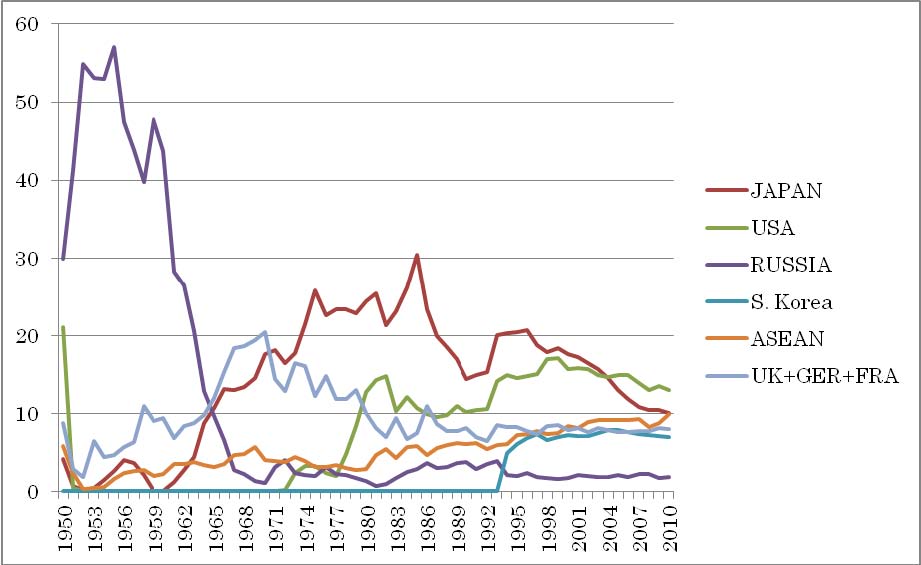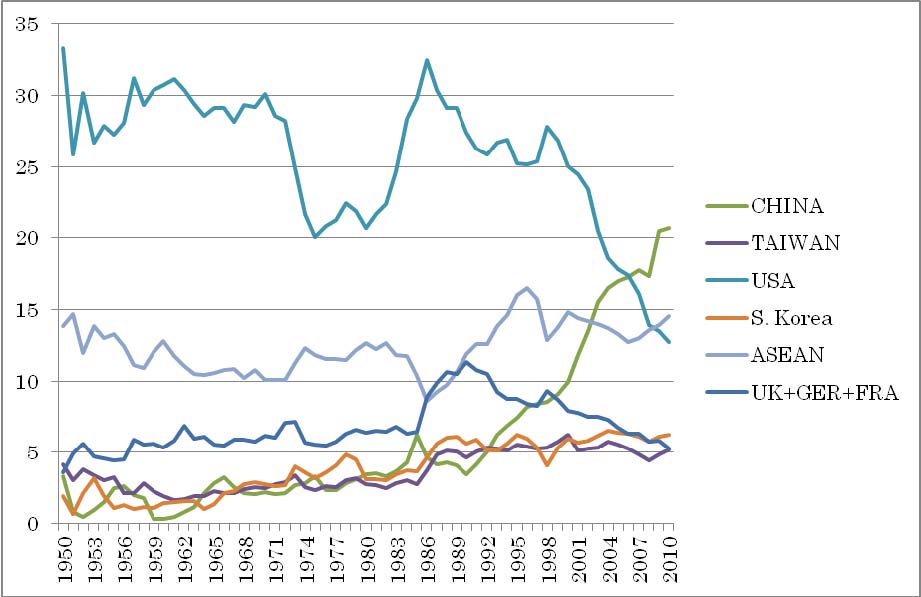- Article
- International Economy
Thinking the Tokyo-Washington-Beijing Triangle from an Economic Perspective
March 18, 2013
Traditional national security arguments tend to frame China’s rise in zero-sum terms, that is, as invariably meaning the decline of other states. But in the context of economics, China’s growth has the potential of bringing positive-sum benefits to all trading partners, including Japan and the United States. And this, more or less, is what has actually transpired.

China’s ties with Japan seriously deteriorated over the Senkaku issue under the administration of Prime Minister Yoshihiko Noda, adversely affecting the activities of Japanese companies in the Chinese market. Improving bilateral ties, thus, will be a key priority of the Shinzo Abe cabinet. On the other side of the Pacific, Barack Obama, reelected to a second term as US president, stated during a debate with Republic challenger Mitt Romney, “China is both an adversary, but also a potential partner in the international community if it is following the rules.” [1]
The notion that economic interdependence encourages international collaboration is nothing new. [2] As trade ties deepen, any conflict-induced interruption in commercial activity will have higher costs, so states have an added incentive to avoid military confrontation. So in the Japan-US-China context as well, it is hoped that increased mutual dependence will help reduce tensions over political and territorial issues.
The key in this trilateral relationship will be the course taken by China. Despite greater interdependence with its neighbors, China is now engaged in harsher territorial disputes with Vietnam and the Philippines in the South China Sea, and ties with Japan have soured over conflicting claims to the Senkaku Islands.
Can heightened interdependence really ease tensions among Japan, the United States, and China and contribute to a stable development of the trilateral relationship? Will Beijing tone down its aggressive political stance or territorial claims in the interest of maintaining economic interdependence?
Below, I will first offer a projection of the directions Beijing’s foreign policy is likely to take from the viewpoint of economic interdependence; Beijing, in a nutshell, is likely to pursue a policy of cooperation with Washington while taking a hard-line stance toward Tokyo. Next, I will consider what this foreign policy stance implies for the trilateral relationship. Close US-Chinese ties are, of course, good news for Japan, but unless Japan and China can resolve their differences, the United States will be placed in the difficult position of having to take one side or the other. I conclude with the thought that the three countries need to proceed cautiously to nurture a stable and cooperative relationship that brings benefits to all three partners.
Economic Interdependence and Chinese Policy
Japan and China were indispensible trading partners even before the 1972 normalization of diplomatic ties. Japan was China’s largest trade partner at the time, accounting for 12% of China’s exports and 22% of imports. [3]
Economic interdependence has deepened significantly over the four decades since then, with the volume of bilateral trade between 1991 and 2011 expanding sixfold; [4] by contrast, Japan-US trade over the same 20 years declined by 20%. [5] Direct investment from Japan to China was just 230 million yen in 1991 but jumped 60-fold to 12.6 billion yen by 2011. [6] Along with the expansion of trade, the number of visitors also grew; while 170,000 Japanese traveled to China in 1980, the figure in 2010 was 3.4 million. And the number of Chinese visiting Japan swelled from a mere 20,000 in 1980 to 1.4 million in 2010. [7]
Deepening economic interdependence does not appear, however, to have tempered Beijing’s assertions on territorial issues. Does this mean that economic ties have had no impact on China’s hard-line policy toward Japan? The answer lies in viewing the Japan-China economic relationship in a broader context that goes beyond bilateral interdependence.
Indeed, a look at the shares of trade accounted for by Japan’s and China’s respective trading partners suggests that bilateral ties have not necessarily grown closer despite the expansion in trade volume. In fact, Japan’s relative importance for the Chinese economy, in one sense, can be said to have declined since 1972.
Figure 1 shows the shares of China’s trade by country/region over a 60-year period from 1950 to 2011.
As the graph shows, Japan has been claiming smaller shares of China’s total trade since the late 1980s, though it remained the biggest trading partner until 2004, when it was overtaken by the United States. In terms of exports, Japan was surpassed by the Association of Southeast Asian Nations in 2009 and now represents only the fifth largest market for Chinese goods. And as for imports, Japan is now China’s third-biggest partner, falling behind the European Union in 2011 and ASEAN in 2012.
Figure 1. China’s Foreign Trade by Country, 1950–2011
(%)

Notes: German figures for 1990 and earlier are for trade with West Germany. Russian figures for 1991 and earlier are for trade with the Soviet Union.
For Japan, by contrast, China’s economic importance has been rising dramatically in recent years, as is clear from Figure 2. The share claimed by China in Japan’s total trade grew steadily from the mid-1990s, eventually topping the United States in 2007. The country is now Japan’s biggest trading partner, accounting for 20% of total trade value.
The leadership in Beijing was generally conciliatory toward Japan until around the mid-2000s, but it began adopting a very hard-line stance from around 2010. This, by the way, coincides with the relative decline in Japan’s share of Chinese trade.
One reason that economic ties remained relatively unscathed by periods of political tension in the postwar era—such as the years of “cold politics and a hot economy” in the early 2000s, when Jun’ichiro Koizumi was prime minister—was because there was real demand in the private sector for the goods that each side was able to supply. The two governments, moreover, did not want to see the political dimension of the relationship dampen the robust trade ties.
But now that Japan’s importance to China’s economic growth is dwindling, Beijing may be less inclined to take special steps to prevent a cooling of the economic relationship. Indeed, even Premier Wen Jiabao, considered the leading voice for the conciliatory approach toward Japan, has taken a hard stance on the Senkaku issue, declaring in 2012 after nationalization that the islands are an inalienable part of China’s territory and that Beijing would make absolutely no concessions on issues concerning their sovereignty and territorial integrity. [8]
Figure 2. Japan’s Foreign Trade by Country, 1950–2011
(%)

Note: German figures for 1990 and earlier are for trade with West Germany.
Now that Japan needs China more than vice versa, Beijing may be tempted to take advantage of the asymmetrical trade relationship to pressure Japan into making political concessions. [9] Following the trawler collision incident near the Senkaku Islands in 2010, media reports noted that China restricted exports of rare earths to Japan. [10] And there were also reports that Chinese customs inspections for imports from Japan were delayed in the wake of Senkaku’s nationalization. [11]
A decline in the share of total trade does not automatically mean, of course, that Japan is a less important economic partner. Imports from Japan, while now trailing behind the EU and ASEAN, are still number one if these two economic groupings are regarded as separate states.
Japan’s exports to China consist largely of electrical machinery, including semiconductors and integrated circuits (23.7% of total exports to China in 2012), general machinery, such as machine tools and car engines (23.2%), chemical products, including plastic (13.9%), and industrial products like steel and nonferrous metals (12.3%). [12]
Using these parts, materials, and machinery from Japan, China exports finished products to the United States, Europe, and other consumer markets. According to data for 2011, 21.8% of China’s imports of iron and steel products, 19.6% of machinery, 19.0% of transport equipment, and 10.4% of electrical machinery were from Japan (see table).
These figures show that while Japan accounts for only 9.3% of China’s total imports, it claims higher shares for many of the goods China needs to produce finished products. Any ban on imports from Japan, therefore, would likely be a double-edged sword that could hurt domestic businesses as well.
Table. Share of China’s Imports, 2011
($ billion)
|
Japan’s Exports to China (A) |
Total Imports (B) |
A/B (%) |
|
|
Total |
161,467 |
1,743,484 |
9.3 |
|
Iron and steel products |
8,398 |
38,604 |
21.8 |
|
General machinery |
39,077 |
199,295 |
19.6 |
|
Transport equipment |
15,811 |
83,030 |
19.0 |
|
Electrical machinery |
36,622 |
350,951 |
10.4 |
|
Chemical products |
21,195 |
211,221 |
10.0 |
Sources: (Japan’s exports) JETRO; (China’s imports) China Statistical Yearbook , 2012.
Note: Classifications based on two-digit Harmonized System codes.
The problem is that there appears to be a tendency for China to draw such a sword in spite of the consequences. This suggests that Beijing either misunderstands or underestimates Japan’s importance as an economic partner. [13]
By contrast, China’s attitude toward the United States—now its biggest trading partner—is likely to remain amicable. Over the past 10 years under President Hu Jintao, Beijing has pursued a conciliatory policy toward Washington. The friendly mood has been further enhanced since Barack Obama entered the White House; attaching priority to Asia, he launched the US-China Strategic and Economic Dialogue in April 2009.
New President Xi Jinping is unlikely to waver from the course advanced by his predecessor, lest he open himself up to criticism. Noting that Hu “outlined China’s views on the international situation and its foreign policy in an all-round manner,” at the Eighteenth National Congress of the Communist Party of China, Foreign Ministry Spokesperson Hong Lei said that China will “comprehensively develop its friendly cooperation with countries around the world” under its new leaders. [14]
Implications for the Trilateral Relationship
A stable US-China relationship is certainly not bad news for Japan, as it eliminates the need to choose sides between its sole alliance partner and its largest trading partner. A further expansion of US-China trade would also bring benefits for the Japanese economy.
As described above, the trilateral relationship is marked, to a degree, by an international division of labor, where Japan exports core parts to China, which assembles them into finished products for export to the US and other consumer markets. [15] Apple’s iPhone, for instance, is assembled at a Chinese factory of a Taiwanese electronics manufacturer, but 40% to 50% of the parts that go into the smartphone are made by Japanese companies. The display is manufactured by Japan Display, the battery by Sony, and the flash memory by Toshiba. [16]
In other words, while the United States is now China’s biggest trading partner, exports to the US market is being sustained to a significant degree by imports from Japan. Since such a division of labor benefits Japan only when Chinese exports are thriving, expanded US-China trade ties should be welcomed by Japan.
Given the current tensions in Tokyo-Beijing ties, though, there are fears that as the US-China relationship grows more intimate, Japan could find itself being “dumped” by its longtime alliance partner. If the bickering between Tokyo and Beijing escalates into open conflict, whose side will Washington take? This is the choice that the Senkaku issue could force on the United States.
As of now, the choice is clear. US Congress approved the National Defense Authorization Act for fiscal 2013 that reaffirmed the Senkaku Islands as being subject to Article 5 of the Japan-US Security Treaty, obliging the United States to defend Japan in case of hostilities. The bill also states that the United States “opposes efforts at coercion, the threat of use of force, or use of force by any claimant in seeking to resolve sovereignty and territorial issues in the East China Sea.” Just before stepping down as secretary of state, Hilary Clinton sent a clear message to Beijing, saying, “We oppose any unilateral actions that would seek to undermine Japanese administration” of the Senkaku Islands. As long as Washington maintains this stance, stronger US-Chinese trade ties will also benefit Japan.
At the same time, Washington will always be placed in the difficult position of having to choose sides each time differences flare up between Tokyo and Beijing. Until very recently, Taiwan was considered the “main obstacle” to closer US-Chinese ties. This view was voiced by Deng Xiaoping, who noted that if mishandled, the Taiwan issue could become an “explosive” one for the bilateral relationship. One might venture to say that Japan is now slowly replacing Taiwan as the “main obstacle” to closer to US-Chinese relations.
Stabilizing the Trilateral Relationship
To conclude, from the perspective of economic importance, China is, for the moment, likely to pursue a policy of cooperation with the United States while taking a hard-line stance toward Japan. Closer US-China ties are good news for Japan, inasmuch as one is an alliance partner and the other is the top trading partner. But unless tensions between Japan and China subside, the United States will be confronted with having to choose sides, and Japan could even become an “obstacle” to warmer US-China relations.
How, then, can the trilateral relationship be stabilized so that all three parties reap benefits? For a start, they must all proceed cautiously so as not to exacerbate a very delicate situation.
It is absolutely crucial that the United States not desert its alliance partner on the Senkaku and other issues over which Beijing and Tokyo are at odds. Through its alliance with Japan, the United States should maintain a strong military presence in Northeast Asia. It should also ensure a power balance in the region, including through arms sales to Taiwan.
China needs to refrain from dispatching planes and ships into the Senkaku area and from threatening Japanese ships with weapons-targeting radar. These provocations can lead to accidents that could force the United States to enter a fight on one side or another.
Japan, too, must not take actions that could destabilize the region or become an “obstacle” to closer US-China ties. On issues like the Senkakus, over which Tokyo and Beijing do not see eye-to-eye, Japan should take pains to avoid a heightening of tensions. After all, a stable trilateral relationship will bring benefits not only to Japan but to all three partners.
[1] Third presidential debate, October 22, 2012, in Boca Raton, Florida.
[2] The liberal school of international relations argues that increased interdependence between countries reduces the chances of them engaging in conflict. For example, see Bruce Russett and John Oneal, Triangulating Peace: Democracy, Interdependence, and International Organizations (New York: Norton, 2001).
[3] National Bureau of Statistics of China, China Statistical Yearbook , 1981.
[4] Calculation in Japanese yen. Ministry of Finance, Trade Statistics of Japan .
[5] Ibid.
[6] Japan External Trade Organization (JETRO), Japan’s Outward and Inward Foreign Direct Investment.
[7] Japan National Tourism Organization (JNTO), Visitor Arrivals and Japanese Overseas Travelers.
[8] Xinhuanet.com Japanese news site, September 11, 2011: http://jp.xinhuanet.com/2012-09/11/c_131841961.htm (accessed on December 6, 2012)
[9] Robert Gilpin notes that imbalances in the level of trade dependence are often used as tools of external political manipulation. Robert Gilpin, The Political Economy of International Relations (Princeton University Press, 1987).
[10] One example is “China Lifts Rare Earth Export Ban to Japan: Trader,” Reuters, September 29, 2010.
[11] Examples include “Chugoku, Nihon seihin kensa kyoka: Senkaku hofuku sochi ka” (China Strengthens Inspections of Japanese Products: A Retaliation Measure for Senkaku?), Yomiuri Shimbun , September 21, 2012, evening edition; “Nihon seihin no zeikan kensa kyoka: Chugoku, Tenshin, keizan seisai no ugokika” (Japanese Products Subject to Stiffer Customs Inspections in Tianjin, China: Outcome of Economic Sanctions?), Asahi Shimbun , September 21, morning edition; and “Chugoku, Nikkei kigyo no tsukan genkakuka” (China Strengthens Customs Clearances Standards for Japan-Affiliated Companies), Sankei Shimbun , September 21, 2012, morning edition.
[12] JETRO, Japan-China Trade in 2012.
[13] Even economic experts at the Chinese Academy of Social Sciences, China’s leading government-affiliated research institute, contend that the Chinese economy “no longer needs trade with Japan.” Statement made at a Japan-US-China symposium in Beijing, March 2, 2013.
[14] Press conference by Foreign Ministry Spokesperson Hong Lei, November 15, 2012. http://www.mfa.gov.cn/chn/gxh/tyb/fyrbt/jzhsl/t989479.htm. Accessed on November 30, 2012.
[15] For the structure of international trade in East Asia, see the Ministry of Economy, Trade, and Industry, “Structure of International Division of Labor in East Asia and Its Change,” White Paper on International Economy and Trade 2012 , pp.295-316.
[16] “Nihonsei buhin no dokudanjo” (The Unrivaled Position of Japanese Parts), Nihon Keizai Shimbun , October 19, 2012.
